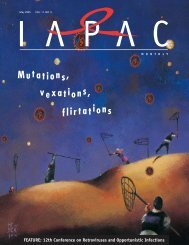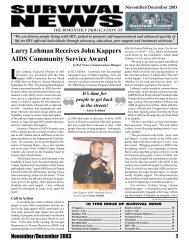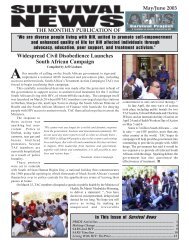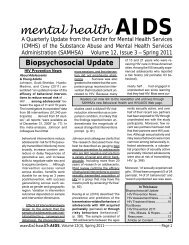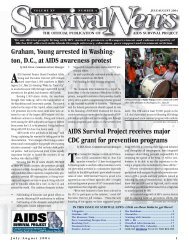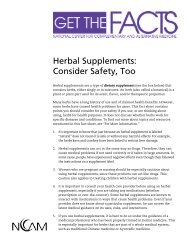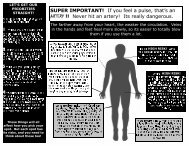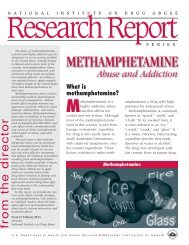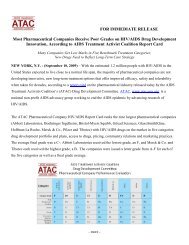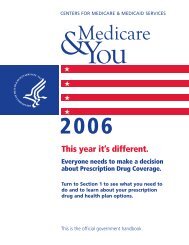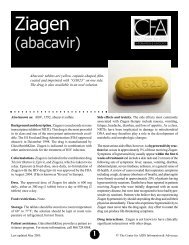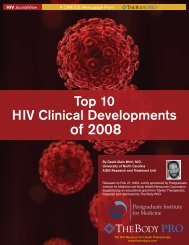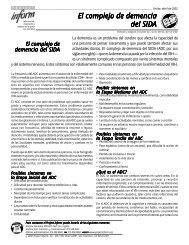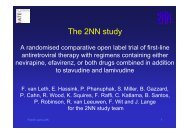WELLNESS STARTS WITH AWARENESS - CD8 T cells - The Body
WELLNESS STARTS WITH AWARENESS - CD8 T cells - The Body
WELLNESS STARTS WITH AWARENESS - CD8 T cells - The Body
Create successful ePaper yourself
Turn your PDF publications into a flip-book with our unique Google optimized e-Paper software.
<strong>The</strong> Buzz continued<br />
and tipranavir were allowed to be added, there were more declines<br />
in viral load.<br />
At the time of this writing, the current issue of the New England<br />
Journal of Medicine (July 24, 2008) reported the fi ndings of<br />
treatment with raltegravir (RLV) in a combined analysis of both<br />
Benchmark studies, which looked at treatment-experienced<br />
patients. Also common to the Gilead study, only patients who were<br />
resistant to three classes of HIV drugs were included. Overall the<br />
results showed a caliber of viral suppression being among the best<br />
ever seen for patients with triple-class resistance. At week 16, the<br />
combined analysis of both studies showed 72% of patients on raltegravir<br />
achieved viral loads below 400 copies, compared with 37%<br />
in the control group. Also at week 48, 62% of patients treated with<br />
RLV achieved a level of HIV-RNA to below 50 copies, compared<br />
with 33% in the placebo arm. It’s worth noting that when patients<br />
were also treated with either darunavir (Prezista) or enfurvitide<br />
(Fuzeon), or both, the rates of HIV suppression were even greater.<br />
Although the rates of side eff ects and adverse events were<br />
low during the 48 weeks of RLV treatment, part of the journal’s<br />
article was devoted to the issue of new malignancies and cancers<br />
seen in the raltegravir group. Cancer in this study was seen early<br />
during the trial (average time of diagnosis was at 68 days) and was<br />
observed at a rate of 3.5% in the RLV treated patients versus 1.7% in<br />
the control arm. It is well worth noting that cancers are increasing<br />
among patients with HIV disease and are of a diff erent type than<br />
was seen prior to HAART. Also, new malignancies have now been<br />
seen in other studies, as well. Historically, we witnessed Kaposi’s<br />
GS 9350 has the potential of<br />
permanently replacing Norvir<br />
as a booster, especially if it<br />
is priced properly, which one<br />
would expect.<br />
sarcoma (KS) and non-Hodgkins Lymphoma to be the most common<br />
of cancers in this population. Presently, anal cancer, liver<br />
cancer, and Hodgkin’s lymphoma are becoming increasingly more<br />
common. Th is is probably due in part to patients having damaged<br />
immune systems and individuals who have had detectable virus in<br />
the blood (persistent viremia). Th us, it is the opinion of this author,<br />
50<br />
that treatment of HIV disease be initiated earlier and that detectable<br />
viral loads be treated with a more eff ective regimen at the onset<br />
of failure. In other words, not to let continued failing regimens be<br />
left untreated, regardless of CD4 T-cell count.<br />
Additionally, the theory of immune system activation (immune<br />
reconstitution syndrome) seen commonly when starting or initiating<br />
a new regimen has also been invoked as a possible cause of<br />
detection of cancer. Herpes zoster (shingles) is one of the most common<br />
manifestations of immune reconstitution syndrome. As the<br />
immune system goes into overdrive, sometimes unexpected events<br />
can happen, that is, new infections, as well as cancers, can occur<br />
during this period of new treatment. Physicians should be increasingly<br />
on the lookout for new problems when patients’ immune systems<br />
are challenged with new therapy.<br />
Norvir may become erased!<br />
A new one pill, once-daily cocktail<br />
Raltegravir is currently dosed at 400 mg twice daily, while elivitegravir<br />
is dosed once daily but at 150 mg plus 100 mg of ritonavir<br />
as its booster. Gilead Sciences has oft en been shown to be a leader<br />
in development of HIV treatment (i.e., Vistide, Viread, Truvada,<br />
and Atripla, all keystone accomplishments); most were surprised<br />
with the recent announcement of their development of a new compound<br />
that can serve as a booster (like Norvir) to EVG, and to other<br />
protease inhibitors. Th e compound known presently as GS 9350<br />
is purely a pharmacokinetic enhancer and<br />
does not have antiviral eff ects. As such, it<br />
is not expected to cause the metabolic side<br />
eff ects that have been associated with Norvir.<br />
GS 9350 has the potential of permanent-<br />
ly replacing Norvir as a booster, especially<br />
if it is priced properly, which one would<br />
expect.<br />
Th is begs me to refer to the movie<br />
“Eraser” with Arnold Schwarzenegger.<br />
Among Arnold’s one liners are “You’ve just<br />
been erased,” or referring to being erased,<br />
“Next time you’re dead… this only happens<br />
once.” One of these greetings may eventually<br />
be handed to Norvir, if development of<br />
GS 9350 goes according to plan. Anyhow, Gilead will eventually<br />
combine their enhancer or booster with EVG to be formulated into<br />
a one dosing tablet. Also, look on the horizon for EVG combined<br />
with GS 9350 plus Truvada, as a new one pill once-daily treatment<br />
cocktail currently being called QUAD, again, if the future studies<br />
continue to go smoothly.<br />
PA • September / October 2008 • tpan.com • positivelyaware.com<br />
Positively Aware



